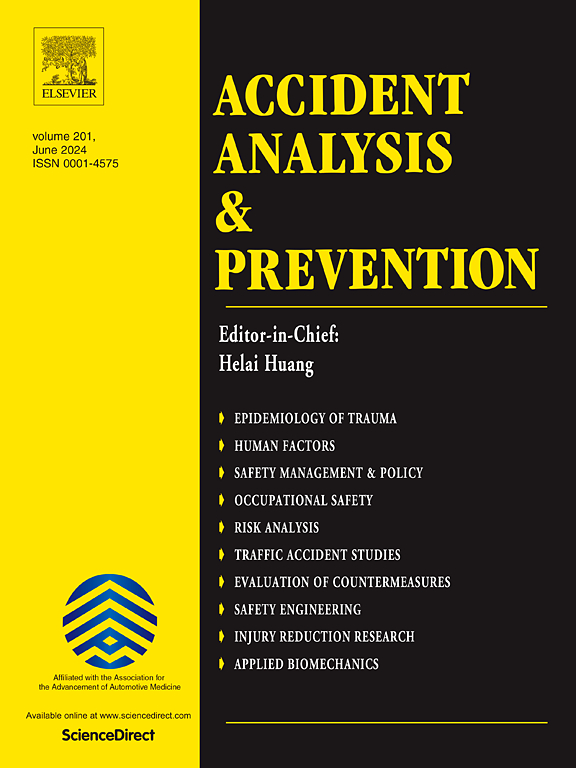Dynamic evaluation of emergency lane occupation based on an improved driving risk field model
IF 6.2
1区 工程技术
Q1 ERGONOMICS
引用次数: 0
Abstract
In China, the frequent occupation of emergency lanes on highways significantly affects traffic efficiency and safety. This study collected data from six highway segments and extracted lane-changing (LC) behavior. A logistic regression model was employed to identify key factors influencing emergency lane changes (ELC). An improved driving risk field model was developed to assess risks during the LC process, integrating the heading angle of the obstacle vehicles, speeds of both the main and obstacle vehicles, as well as the filtering effect of lane lines. Compared to three existing risk field models, our model provides a more accurate assessment of collision risks during lane changes. This study revealed that the primary reasons for ELC are driven by the pursuit of speed and driving space, influenced by the speed and relative distance of surrounding vehicles, and the intention to overtake. Moreover, ELC is characterized by reduced lateral speed and acceleration, as well as a lower minimum time-to-collision (TTC), while exhibiting higher acceptable risks. Risk variation trends during lane changes from emergency to normal lanes include conservative, general, and aggressive types, while changes from normal to emergency lanes feature only conservative and general types. Additionally, ELC significantly negatively impacts following vehicles in the target lane after LC, leading to greater lateral displacement, more significant longitudinal deceleration, and heightened risk levels.
基于改进驾驶风险场模型的应急车道占用动态评价
在中国,高速公路应急车道的频繁占用严重影响了交通效率和安全。本研究收集了六个高速公路路段的数据,并提取了变道(LC)行为。采用logistic回归模型识别影响紧急变道的关键因素。建立了一种改进的行车风险场模型,综合了障碍车的航向角、主车和障碍车的速度以及车道线的滤波效应,对LC过程中的风险进行了评估。与现有的三种风险场模型相比,我们的模型可以更准确地评估变道过程中的碰撞风险。本研究发现,超速驾驶的主要原因是对速度和行驶空间的追求,受周围车辆速度和相对距离的影响,以及超车意愿。此外,ELC的特点是降低横向速度和加速度,以及更低的最小碰撞时间(TTC),同时表现出更高的可接受风险。从紧急变道到正常变道的风险变化趋势包括保守型、一般型和激进型,而从正常变道到紧急变道的风险变化趋势只有保守型和一般型。此外,低速行驶对目标车道上的尾随车辆产生显著的负面影响,导致横向位移更大,纵向减速更显著,风险水平更高。
本文章由计算机程序翻译,如有差异,请以英文原文为准。
求助全文
约1分钟内获得全文
求助全文
来源期刊

Accident; analysis and prevention
Multiple-
CiteScore
11.90
自引率
16.90%
发文量
264
审稿时长
48 days
期刊介绍:
Accident Analysis & Prevention provides wide coverage of the general areas relating to accidental injury and damage, including the pre-injury and immediate post-injury phases. Published papers deal with medical, legal, economic, educational, behavioral, theoretical or empirical aspects of transportation accidents, as well as with accidents at other sites. Selected topics within the scope of the Journal may include: studies of human, environmental and vehicular factors influencing the occurrence, type and severity of accidents and injury; the design, implementation and evaluation of countermeasures; biomechanics of impact and human tolerance limits to injury; modelling and statistical analysis of accident data; policy, planning and decision-making in safety.
 求助内容:
求助内容: 应助结果提醒方式:
应助结果提醒方式:


